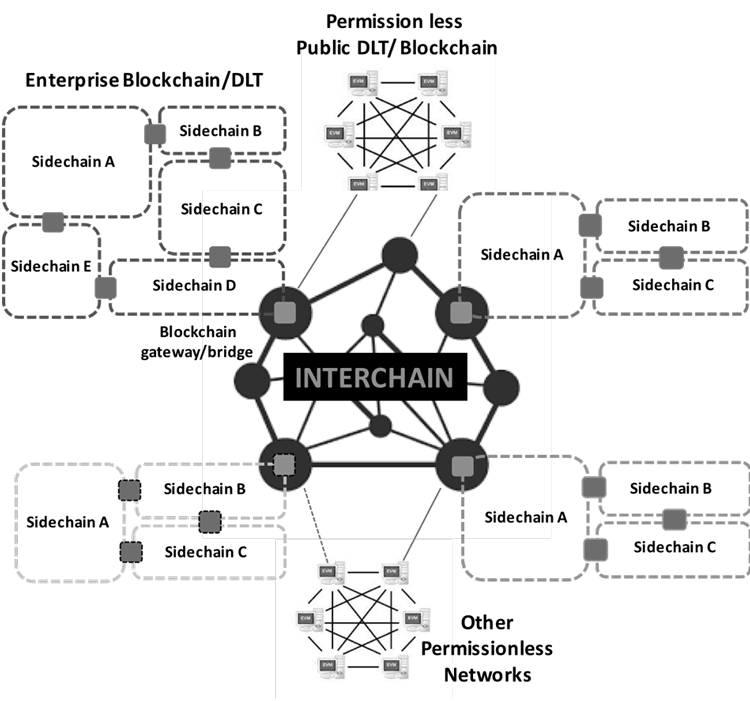Distributed Ledger Technology (DLT)/ Blockchain is being introduced as the new Internet layer of value, adding the “trinity of Ts” [1]—trustability, transparency, and traceability—to any asset class transaction (information/data and physical goods) in the Internet that can be authenticated, validated, traced and registered in a distributed, peer-to-peer (P2P) digital ledger system [2], also addressing data privacy and security [3]. Blockchain is also part of a broader scope of Distributed Ledger Technology (DLT) that is becoming the underlying layer of the future of the Internet, creating a new wave of Decentralized Applications, called “DApps,” that will be introduced to replace most of today’s centralized, cloud-based Internet applications. With Blockchain, businesses will experience a complete transformation of their current models by removing intermediaries, reducing costs, and improving the trustability of the Internet—and, therefore, enabling a new wave of decentralized services.
DLT is an enabling technology of the new information technology (IT) enterprise system and processes, with substantial work developed on the permissioned, enterprise- and consortium-based Blockchain side, addressing real IT problems and vertical-market solutions. Hybrid public-enterprise-consortium DLT Blockchain architecture frameworks are expected for future use case applications that create an inter-working and interoperable Interchain solution, similarly to what happened with Intranet and Internet networking in the early 80s.
Currently, the Blockchain industry is completely fragmented with different alternatives, such as, open and proprietary platforms that support permissioned or permissionless, public, enterprise or consortium-based solutions. In addition, there is no relevant consistent standardization across different technologies and platforms to address the issues of interoperability or interworking.. Therefore, interoperability is becoming an important topic that needs to be addressed if the DLT Blockchain industry ecosystem wants to survive in the near future [4], where today, standards for global mass Blockchain adoption are still lacking.
Most of today’s Blockchain standards activities are focused on specifying and developing generic frameworks, interfaces, and technology modules that work in self-contained or specific platform environments, or industry vertical market [4,5]. Once more complex uses of DLT Blockchain are required across multiple enterprise segments, between enterprise or consortium-based and public (permissionless), or between multiple enterprises to run more complex use cases, requirements, and implementations, then there will be a strong need for an end-to-end DLT Blockchain interoperability standards [4]. A typical set of DLT Blockchain standards with focus on interoperability and scalability are among several industry Blockchain requirements that are essential for the survival and mass adoption of Blockchain as an enabler of the decentralized Web 3.0 Internet.
In particular, the IEEE Blockchain in Energy WG global standards [5] is currently working to address the need for DLT Blockchain open and interoperable standards for the energy industry, which is considered to be a complex multi-segment, multi-domain vertical market requiring multiple DLT Blockchain solutions that are open and interoperable, where the concept of “one size fits all” does not apply. In this new standards proposal, the end-to-end energy grid segmentation, with different types of DLT Blockchain frameworks are used to address a particular set of use case applications. Each segment will have its own DLT solution, that at some point, may need to interoperate with other segments to transfer value, assets, and tokens between these multiple platforms. This is just one application of a particular industry vertical. Similar concepts can be extended to other industry segments.
It is expected that within the next few years, there will be a strong need for cross-chain interoperability between different enterprise-grade (permissioned) and public (permissionless) DLT systems, where different platforms will interact with one another to make the development of unified or multi-wallet DApps with inter- and intra-token transactions between different Blockchain platforms much easier, efficient, scalable, and pervasive. Multiple sidechains (a special class of Blockchain) will be required, each performing a specific DLT function, and interoperability between these multiple network segments shall be defined using a common-ground protocol, or some bridge/gateway artifact. This will be the ultimate requirement for the creation, consolidation, and interconnection of multi-DLT Blockchain technologies, as the future of decentralized networks and services (also called Interchain) as shown in Figure 1.

Figure. 2 – DLT Blockchain interoperability between permissioned and permissionless networks. source: Blockchain Engineering Council-BEC
Key Takeaways Creating open and interoperable DLT Blockchain standards is an important step to connect multiple open source and proprietary technology platforms that are geographically dispersed, and serve different industry verticals and use cases. This is an important step for the evolution of Blockchain as an enabler of the Internet of Trust and the new enterprise IT layer. Global standards, such as the IEEE Blockchain standards series, are addressing these generic and interoperable frameworks.
Standard, IEEE computer society, December 2018 (upcoming). [5] IEEE P2418.5 Blockchain in Energy Standards WG, https://standards.ieee.org/project/2418_5.html.
 Dr. Claudio Lima (lima@blockchain-eng.org)
Dr. Claudio Lima (lima@blockchain-eng.org)
